Discover what Entreq can bring to your system with the Tellus 2 Infinity line grounding box and Eartha cables.
The Entreq Tellus II Infinity Line is one of the most intriguing additions to the Tannoyista system I've ever had the pleasure of owning. It has no moving parts, no mains cable and is encased in beautifully finished solid wood.
The Entreq Tellus II Infinity Line grounding box arrived very well packaged. Together with the Tellus II came another box containing the Eartha grounding cables including an RCA and RJ45 grounding cable.
Unboxing and First Impressions
Starting with the Tellus. Firstly, the packaging is excellent. Having something delivered which is made of wood can sometimes be an anxious moment but I was so glad to see that extensive thought had gone into this.
The Tellus is wrapped in bubble wrap inside a protective foam shell inside a protected heavy gauge cardboard box.
The first thing we see is a note giving you advice on looking after the unit. In this case, the casework is treated with Beeswax so to keep the wood looking its best only beeswax should be used in the future. One thing you do notice is the lovely smell of beeswax.
On removing the Tellus from its packaging, the first thing you notice is the weight. Weighing in at 15kgs, its solidity instantly feels gratifying.
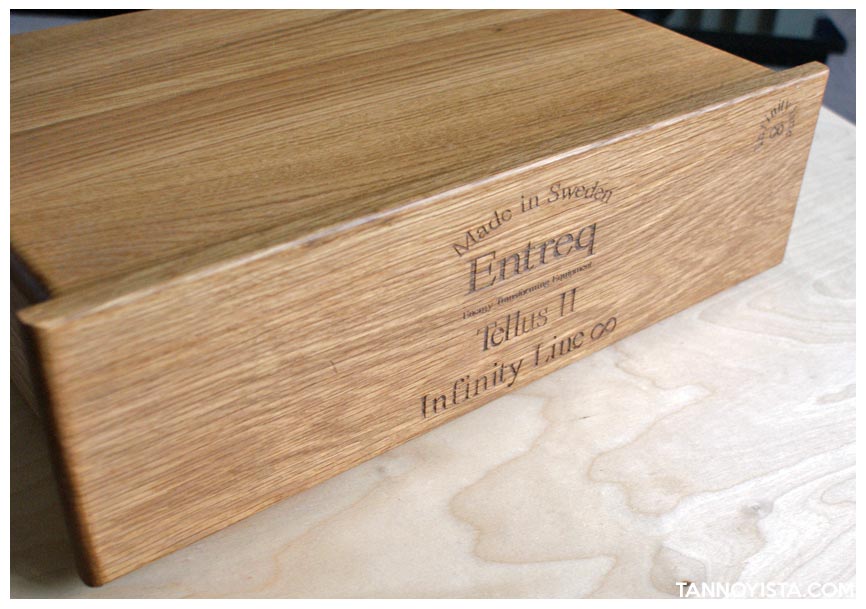
The packaging of the Eatha cables introduces you to the idea of the Entreq way of thinking for equipment grounding. Each Eatha cable arrives inside its own padded wooden box.
Each box lid is screwed shut so a screwdriver is required to open each box, and inside, the cable sits cosily surrounded by foam padding. This is something which I felt was really interesting.
To have to physically open something in this way shows that Entreq is different and certainly not a typical ancillary company for Hi-Fi.

The physical size of the Tellus II Infinity Line is H=12cm x W=43cm x D=31cm. So it's a very good size and averages the footprint of a typical amplifier. On the underside are three wooden feet with threaded inserts so spikes or other kinds of feet can be used.
The Tellus II Infinity Line is beautifully finished. Made from solid, it wood has a very nice deep grain to which the beeswax helps to bring out. There are no screws to be seen and the construction is very solid. On the front of the Tellus is the logo and model which are laser etched.
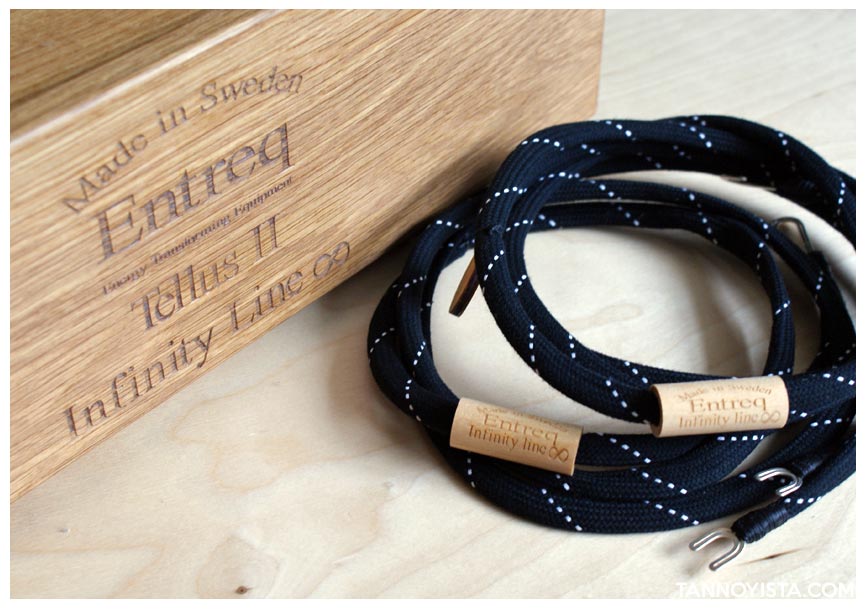
Connecting the Entreq
On the rear of the Tellus are three grounding connection posts. Each post is numbered. No.1 is the central connection. This connection post is silver plate over copper whilst connection posts 2 and 3 are pure copper.
Each post is made to a very high quality and is similar to the CARDAS CCRR and CCBP types of binding posts. To top it off, instead of a metal type tightening thumb nut, the thumb nuts on the Tellus are wood-turned and have a great shape/feel.
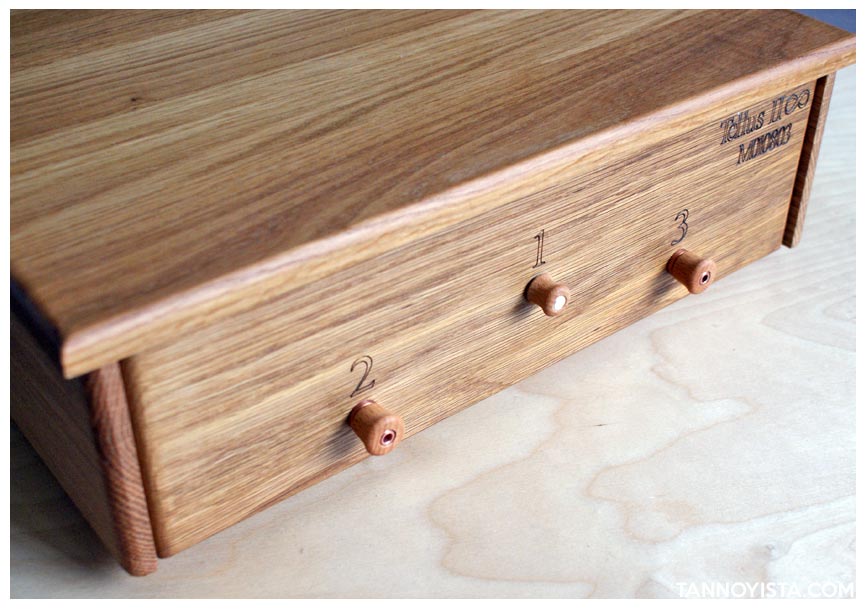
Inside the Tellus, it is split into 3 individual boxed grounding sections so each connection has its own independent internal box for optimal grounding separation.
The Eartha Grounding Cables
The Eartha grounding cables have a very nice soft and pliable feel to them. The outer braiding is soft black cotton with white flecks and at each end (where the connectors are secured) the cables are cotton wound as opposed to the typical plastic shrink, bringing a nice artisan feel to them.
At one end of the cables is a wooden identity bobbin, laser-etched with the Entreq logo and type. The Eartha cables are very lightweight, and flexible and can be routed behind the system very easily.
The connectors are a flat section wire design, silver plated over copper with one end like a traditional spade, and the other end, a hook.
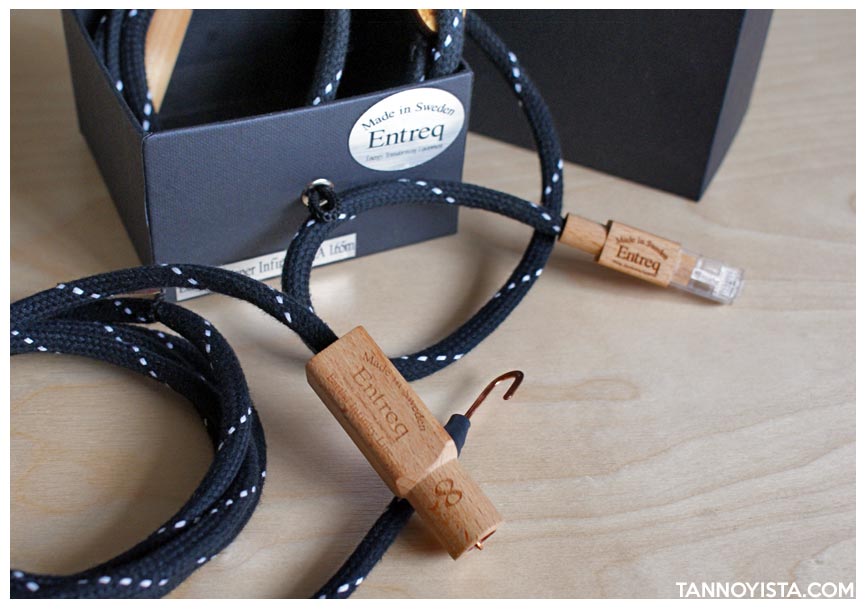
The RCA and RJ45 network cables are constructed in much the same way with silver-plated connectors. The body of the RCA connector is also turned wood and fits into the RCA socket very snuggly indeed.
The RJ45 plug body is also made of wood. Grounding using the RCA plug is as simple as connecting it to any spare or unused negative socket on your equipment such as your preamp. The network connector is much the same, although it may be easier to connect it to a bridge if you have no spare network socket at the back of your equipment.
In my case, both the RCA and RJ45 are grounded to the centre connection pole (No.1) on the back of the Tellus whilst the other two connectors (No.2 & No.3) link to the left and right negative loudspeaker posts of my amplifier.
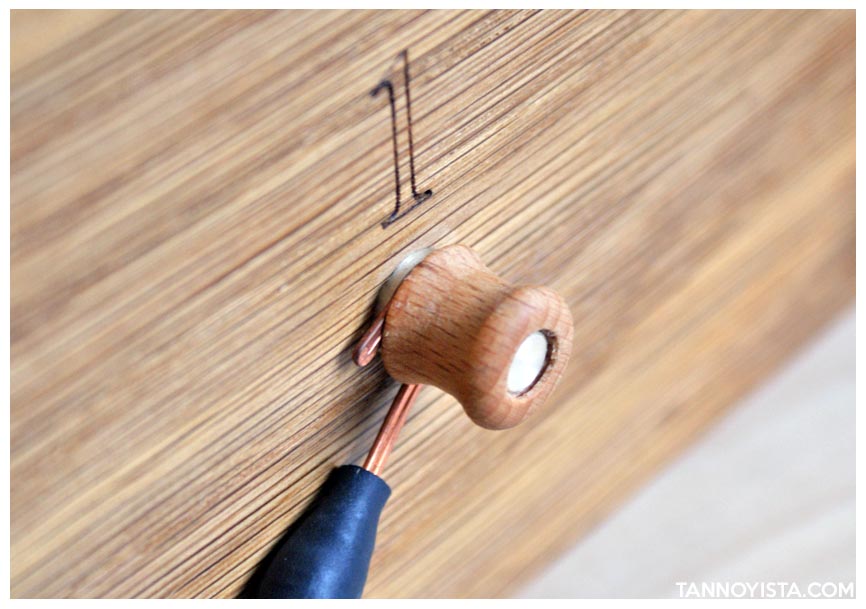
Of course, you can connect more than just one component to any section of the Tellus. And Entreq produces even larger units for bigger and more complex systems.
In my case, I have many other components and combinations I'd like to connect to other types of Entreq grounding boxes, including my Studer A80. But that's for another day.
Connecting the Tellus to the big Tannoy loudspeakers
One of the most intriguing aspects about the Tellus is finding out what the effect would be by grounding my 15" Tannoy Monitor Gold loudspeakers inside some Lockwood Major cabinets.
Discover more about the Original Trident Studio Tannoy Lockwood Majors.
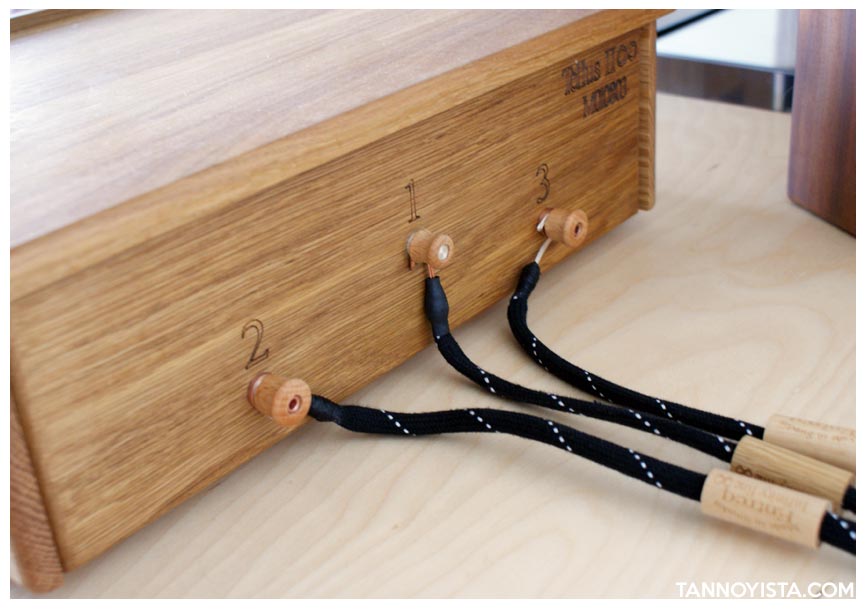
What do Entreq grounding boxes actually do? If you own a nice system with high-quality components, the chances are they were designed to run a signal as clean as possible. Although even our beloved Hi-Fi can put out its own induced noise, unknowingly adding more noise from the home to the signal isn't ideal for us.
Home is where the heart is, and it's also where we enjoy our music. My system has its own dedicated mains source although not its own dedicated earth. So in any system hooked up to a home power supply, or even if you have a dedicated supply to your Hi-Fi with or without dedicated earth, there will be contaminants adding noise along the signal line at some point.
Unknowingly to many things like a Fridge Freezer, Mobile charger, Internet router and/or those horrid switch-mode PSUs can all add noise to the signal. You would be surprised how many switched-mode PSUs there are in homes these days and in your Hi-Fi chain.
What does noise do?
Signal noise kills transients and detail. The more noise you have in your ground signal, the less of the finer areas of your music will be heard. Of course, some people have more noise than others so its difference in degree is, of course, obvious but it's not until you remove the noise that you understand its negative and damaging effects.
The Entreq grounding boxes work with signal ground noise. Although noise from other bits of kit can be only very slight, that doesn't mean it's not having a negative effect on the performance of your entire system. The Entreq range of grounding boxes fixes this as they drain off the noise in the signal path, thus opening up the sound.
The Sound with the Tellus
The hooking up of the Tellus II Infinity Line couldn't be simpler and once hooked up and everything switched on and heated up it was time to start listening. My taste in music is quite broad. I range from some classical, 1960s psychedelia, Classic rock, Indie, Dance, Reggae, Trance and Dub.
I have a few albums I consider my staple reference sources on vinyl, digital and tape. Out of all my range, I play mostly Indie, Rock and Dance. But when I do listen to music, I really make sure I'm as tuned in as possible. No distractions.
My system reaches its optimal operation after 30 minutes or so. So I always make sure it's on or beyond this point before I drop the needle, spin a disc, stream some bits or play a tape. So, to kick this off in a gentle manner, some Semprini was on the cards.
Whilst it wasn't one of my reference albums, I know it well enough to give me a good understanding and the sound of the Piano is always a great instrument to start with. Semprini plays with so much ease and effortless fluidity. And at this point, everything was pretty much as it ever was except for one very small aspect which became very evident after the third track.
The amount of air and texture of the piano was always prominent but this started to become even deeper, pulling out more of the hanging overtones. It was like taking a few more steps closer to his piano revealing more vibration and mechanical texture.
It was really quite astounding and after the full album, it was very evident that something was certainly continuing to develop.
"There is no dark side of the moon really. Matter of fact, it's all dark"
You've guessed it. The next album was Pink Floyds, The Dark Side of the Moon. I know this album so well and this version was the Abbey Road 1/2 speed remaster by Bernie Grundman which I have to say is an astounding pressing.
I also own a 1st generation tape copy of this album which is simply phenomenal. From the off, the heartbeat and the mechanical soundscapes of the EMS Synthi AKS and VSC-3 synths had a more serious feel to them, more knarl.
Following through into the other tracks, the instruments take on a more tangible sound, with fewer artefacts and a solidity of realism. Especially the drums and allows an easier flow, building up to the layering of the lyrics.
To have such a low noise floor on this classic album with an increased inky eerie blackness is not only impressive with the Tellus in place but very interesting to boot. It makes you realise how much effort the band made, it brings more insight into them all working together on the desk in real time.
Even that is a performance in itself. Are you Shpongled? The next album is one of my most impressive reference albums and this time, I'm going digital. Firing up the ALLO Revolution DAC it was time to get Shpongled.
Shpongle's Ineffable Mysteries of Shpongleland and Are You Shpongled are the best-sounding and most detailed albums I have in my collection.
I also have this remastered on vinyl which is amazing. But for this, I'm streaming it from my HDD. The album is a Trance/Goa masterpiece. Like all Shpongle albums, they have effects and sounds that really twist your ears (and your brain).
They are such fun albums. Okay... this was very revealing. With the Allo Revolution DAC also connected to the Tellus, things certainly changed. The detail is now more visually focussed and like my previous experiences with vinyl, the revealing of texture was more apparent.
Shpongle really knows how to make sounds wizz around your head and place effects so they distract you from other streams of sound moving in the opposite direction. As I said before, they're so much fun to listen to. The sheer depth of this album has always been breathtaking.
But with the Tellus in position, that depth became another 10ft deeper. The dynamics are more accurate, and transients are more fluid.
Aphex Twin was my next weapon of choice. Again on digital, the album SYRO started up with a deeply dug-in attitude and just keeps getting better. I've never heard this album sound so good. Like Shpongle, Aphex really knows how to drill the bass line and with exquisite detail bring texture and involvement to your ears.
With the Tellus connected, the sound really growls and puts you front and centre into an amazing swirl of sound. At this point, I wanted to know more about what the Tellus was doing. Because I was so surprised with the sound I wanted to simply make sure if it wasn't just my head playing tricks.
So, after the album had finished I took a 30 mins break in silence. I then re-played the second track in full and then paused it. Quickly removing the grounding cables I then re-played the track. Conclusion... It wasn't my head.
The sound without the Tellus was effectively narrower, less detailed and, to be honest, a little lost sounding. So, I then replayed the album from the beginning. Same again, no change. I then took another step back and replayed Pink Floyd on vinyl and, then something new, this time the 2019 album by The Chemical Brothers, No Geography.
But halfway through the first side, I was starting to get a little bit of cold turkey, it just wasn't the same. So, I quickly connected the Tellus again. Initially, the difference wasn't too dramatic, but after just a few tracks, the difference was clear and the sound, as before, started to bloom with the same solidity and focus.
My understanding thus far was that the Tellus takes just a short while to start to really kick in. But like all systems, an initial 10-30 minute warm-up is always recommended before it really starts to boogie. And with the Tellus II Infinity Line connected, that's enough time for it to bring you its magic and develop. A few days later, I started again.
After a 20 mins warm-up, I dropped the needle on some more vinyl, then, a wider selection on digital. As we all know, sitting down in the zone is the place to be. But even if you're just pottering around the house, it's great when something draws you back into the room. Well, with the Tellus in place, those moments have certainly increased tenfold.
It just makes you want to be in the zone all of the time. I then disconnected just my Tannoys from the grounding box. This also made a notable difference in the sound. Without the Tannoys connected the sound seemed to bring less of that beautiful inkiness to the sound, a less togetherness in presentation and feel.
On reconnecting, the stage became more solid and set. And so, breaking things down in regards to connected components. My Tannoy Monitor Golds absolutely love the Tellus and connecting the source points to the Tellus snaps things into place.
Altogether, the connecting/disconnecting of both source and speakers was a very worthwhile insight into what Entreq grounding boxes actually do with sound. I'm not going to ask how Tellus grounding boxes work, but they do.
And in my case, it's the icing on the cake, rather... a rich butter icing with sprinkles and strawberry sauce.
So, here's a breakdown of my experience with the Tellus II Infinity Line grounding box.
- Improved clarity and harmonics.
- Improved focus and texture.
- Improved air and transient details.
- Improved sound floor.
- Improved smoothness and fluidity.
Conclusion
Music is Art, and to distil what Entreq has painstakingly achieved here is this. We all crave more insight into our music and trust the ability of our system to bring it to us, but it's not until you clear up what you thought wasn't there that you realise your system can reach way beyond its once-perceived performance.
My staple advice for anyone upgrading their system is this. Like mains power, it's always the place to start. And, after having the Tellus in my system, I would now tightly recommend an Entreq product of some kind. It's a must, and it makes perfect sense to allow your system (together with your high-end interconnects and speaker cables) to really reveal what it's capable of.
The Entreq Tellus Infinity Line grounding box is so refreshingly simple in its looks and connectivity. For something so natural and easy to use, the increased performance, to be honest, has an intriguing addiction to it. And it makes me wonder how much more there is to get out of my system with Entreq.
To Finish
The Tellus II Infinity Line is very special and has surprised me greatly. It grounds your music into its surroundings, re-aligning and revealing its intended focus, and allowing it to bloom with its intended emotion.
Specifications
Phone: +46 (0)705 200 500
WhatsApp: +46 (0)705200500
Address:
Rönnetorp 18
265 90 S-Åstorp
Sweden





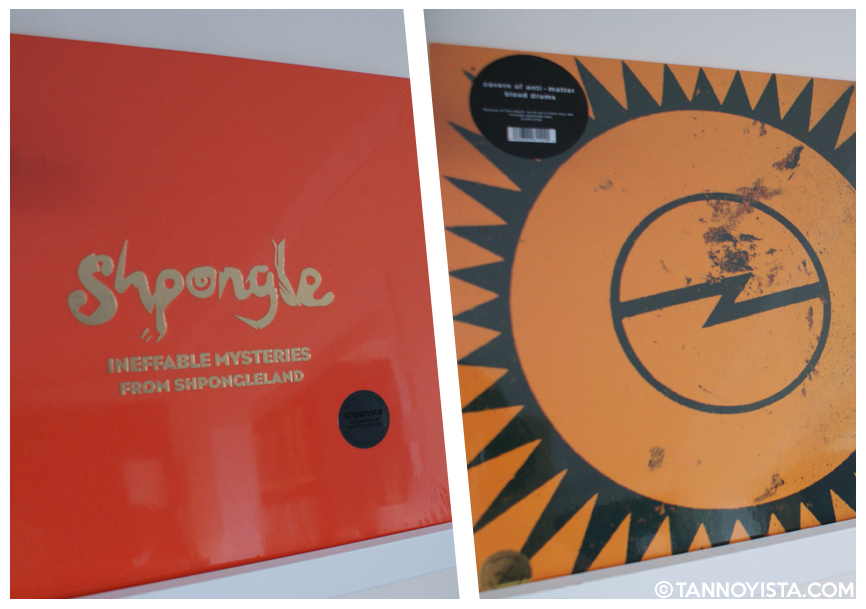
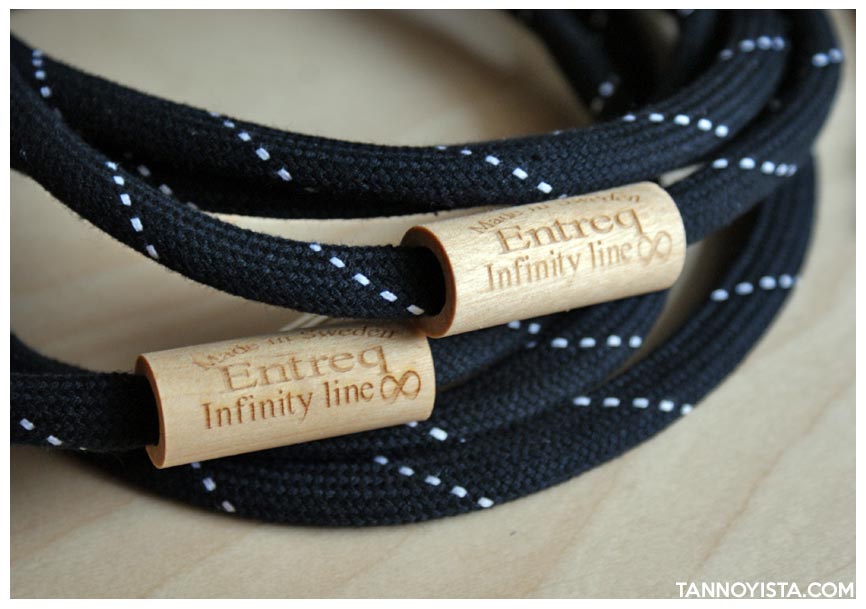




 All the photographs and images on this site are copyright.
All the photographs and images on this site are copyright.
0 comments